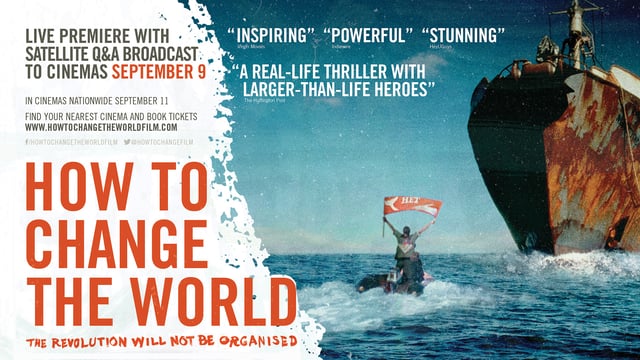There’s a salutary blend of the beautiful and the brutal in Jerry Rothwell’s How to Change the World, a movie about our deepest moral problem – our environment. Based on the memoirs of Canadian ecologist Bob Hunter, Rothwell’s documentary recounts the founding of Greenpeace in 1971 and the subsequent travails of the people involved. It’s a story of heroism, idealism and, as all participants admit, egotism.”
Rothwell tags the movie’s title with the strap-line “The Revolution Will Not be Organised”. It’s a smart paraphrase of Gil Scott-Heron and a witty allusion to the politically activist zeal of the 1960s/70s (currently in revival). It’s also an accurate description of the raggle-taggle bunch from Vancouver who started out protesting against US nuclear development. They were idealistic but inexperienced. They were both green warriors and greenhorns. But they were part of the general zeitgeist vibe that was challenging prevailing power structures and Bob Hunter emerged, reluctantly, as their leader. As Rothwell’s narrative reminds us, it’s not inaccurate to see Hunter as the Martin Luther King of environmentalism. He certainly had similar quantities of charisma and commitment.
Hunter was also tough and prepared to put his own body in danger. In one sage insight he states: “If you wait for the meek to inherit the earth they’ll be nothing left.” The Greenpeace story began when Hunter and his fellow travellers set sail to challenge US nuclear testing at Amchitka, Alaska in late 1971. Among the motley crew were scientists, activists and idealists, like Paul Watson, Patrick Moore and Bill Darnell (who coined the name Greenpeace). Though their collective actions were memorable, relations between them would swing between friendship and fall-out for years. They sailed in a tub resembling a sieve, piloted by a captain nicknamed John “Hard Luck” Cormack. They had little seagoing seasoning or idea how to halt America’s nuclear programme, but they had profound certainty in their own moral compass.
What they also had was a film camera, an old-style 16mm handheld. This turns out an extraordinary stroke of serendipity, both for the fledgling Greenpeace movement and for Rothwell’s movie. Because the activists filmed so much of their activity, they were able to transmit their story to a wider, and indeed welcoming, world. The drama they captured was both natural and immediate, and still packs a gut-wrenching punch. After tripping over bones at an abandoned whaling station, Hunter grew determined to confront the international whaling industry. Footage of what the Greenpeace activists witnessed gives How to Change the World some arresting and appalling imagery. A pristine blue ocean is stained red with spurting whale blood; a carcass is stripped of its skin, which billows in the sea wind like a giant flag.
At one point Hunter kneels on the back of a stricken whale, while the ocean waves surge all around. Another image shows him with his head in the jaws of a killer calf: “She could crush me like an eggshell, but chooses not to.” Greenpeace intuitively understood the power of pictures for public opinion. “Image is everything,” Hunter wrote. As conservationist Rod Marining tells Rothwell: “It’s all about putting on a show.” Though its principles focussed on conserving nature, the Greenpeace movement cannily grasped the means of modern media, especially film and TV. Hunter spoke of a “mind bomb sailing an electronic sea into the living-rooms of the masses.” Later, the movement’s public profile was boosted with the unexpected and undeniably photogenic appearance of Brigitte Bardot. Carli Truman (one of the few female activists) recalls, with some amused annoyance: “The guys were absolutely smitten.”
Among the compelling qualities in How to Change the World is the refusal to flinch from the tensions between its contributors. “We were at each other’s throats,” Hunter remarks. Part of the problem with movements trying to change the world is disagreement over how change is best effected. One dilemma that arose in taking on global trawling corporations was the harm done to the livelihoods of local fishing villages. This tore a hole in Greenpeace’s populist banner. Hunter and Moore wanted to relent on some issues regarding small-scale seal farmers, while Watson thought compromise was “bullshit”. Watson was expelled; Hunter was rueful: “It meant bringing down the axe on the neck of our brother.”
Though Hunter died of cancer in 2005, his fellow activists, now greying and balding, still have fire in their bellies. Their testimonies make powerful viewing. The people interviewed in this movie helped cause a shift in humanity’s consciousness about our place in nature. Whatever one thinks of environmentalism, Bob Hunter, Paul Watson, Patrick Moore, Bill Darnell, Carli Truman and Rod Marining et al should be household names. To Rothwell’s credit he has remembered them in this exceptional documentary.
http:/www.youtube.com/watch?v=2LE9BpQyhCQ

